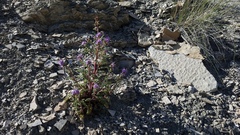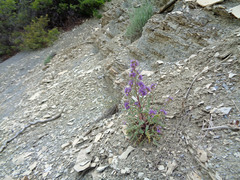Phacelia argillacea: taxon details and analytics
- Domain
- Kingdom
- Plantae
- Phylum
- Tracheophyta
- Class
- Magnoliopsida
- Order
- Boraginales
- Family
- Boraginaceae
- Genus
- Phacelia
- Species
- Phacelia argillacea
- Scientific Name
- Phacelia argillacea
Summary description from Wikipedia:
Phacelia argillacea
Phacelia argillacea is a rare species of flowering plant in the borage family known by the common names clay phacelia and Atwood's phacelia. It is endemic to Utah in the United States, where it is known only from one canyon in Utah County. It is "one of Utah's most endangered species"; it is "one of the nation's rarest plants" and is federally listed as an endangered species of the United States.
This plant is an annual herb growing up to 36 to 40 centimeters in height. It has a rosette of leaves around the base of the stem. The leaf blades are oblong with deep lobes along the edges, and measure up to 5 centimeters in length. The inflorescence is a cyme with several branches that are scorpioid in shape, curving into a curl like the tail of a scorpion; this inflorescence is hairy and glandular. Each flower has a bell-shaped purple-blue corolla about 0.5 centimetres (0.20 in) long and wide, with the long stamens and style protruding from the mouth of the corolla. The fruit of the plant is a capsule about a quarter of a centimeter in length. This plant is generally considered to be a winter annual; it germinates and produces a basal rosette, then develops slowly through the winter beneath the snow. Its erect stem grows up by May. Blooming usually occurs in July, but early blooming can take place in May and June and some flowers can persist into October. One plant can produce up to 8000 seeds. This species is closely related to, and has been mistaken for, Phacelia glandulosa.
This plant is known only from Spanish Fork Canyon in central Utah. It has been on the US Endangered Species List since 1978, at which time there were only nine individuals known. Within two years this tiny population had dwindled to four plants. In 1980 a second population was found, putting the total global population around 200. In 1987 some sheep were bedded at the main locality for three days, and only a single plant survived. Twenty to thirty new plants had germinated the following year.
The plant grows on steep slopes made of clay and broken shale originating from the Green River Formation. The habitat is pinyon-juniper woodland dominated by Pinus edulis (Colorado pinyon) and Juniperus osteosperma (Utah juniper) and other plants in the vicinity include Berberis repens (creeping barberry), Mentzelia laevicaulis (giant blazingstar), Oenothera caespitosa (evening primrose), Marrubium vulgare (horehound), Cynoglossum officinale (houndstongue), Amelanchier alnifolia (serviceberry), Rhus trilobata (skunkbush), Atriplex canescens (fourwing saltbush), Artemisia tridentata (sagebrush), Chrysothamnus nauseosus (rabbitbrush), Cercocarpus montanus (mountain mahogany), and Rosa woodsii (Woods' rose).
The species faces a number of threats. Its small numbers put it at risk for extinction. Sheep graze in the immediate vicinity of the plants, in addition the plants may be eaten by native animals such as mule deer and rock squirrels. One occurrence is next to railroad tracks, and the construction and maintenance of the rails has disturbed the habitat. Highway 6 runs directly through another occurrence, and road maintenance may disturb the plants as well as the habitat that supports their potential pollinators. Introduced species of plants, such as horehound and houndstongue, may compete with the phacelia.
Conservation activities include the propagation of plants and collection of seeds. Both natural populations occur on private land, where they are difficult to protect. Seeds grown in cultivation will be used to establish thirteen populations on federal land in Uinta National Forest, where they can be protected. As of 1988, The Nature Conservancy was attempting to acquire the species, without success.
...Phacelia argillacea in languages:
- English
- Clay phacelia
Images from inaturalist.org observations:
We recommend you sign up for this excellent, free service.
Parent Taxon
Sibling Taxa
- Phacelia adenophora
- Phacelia affinis
- Phacelia alba
- Phacelia altotonga
- Phacelia amabilis
- Phacelia ambigua
- Phacelia anelsonii
- Phacelia argentea
- Phacelia argillacea
- Phacelia argylensis
- Phacelia arizonica
- Phacelia artemisioides
- Phacelia austromontana
- Phacelia bakeri
- Phacelia barnebyana
- Phacelia beatleyae
- Phacelia bicolor
- Phacelia bipinnatifida
- Phacelia bolanderi
- Phacelia bombycina
- Phacelia brachyantha
- Phacelia brachyloba
- Phacelia breweri
- Phacelia buell-vivariensis
- Phacelia californica
- Phacelia calthifolia
- Phacelia campanularia
- Phacelia capitata
- Phacelia carmenensis
- Phacelia cedrosensis
- Phacelia cephalotes
- Phacelia cicutaria
- Phacelia ciliata
- Phacelia cliffordii
- Phacelia cloudcroftensis
- Phacelia coerulea
- Phacelia congdonii
- Phacelia congesta
- Phacelia constancei
- Phacelia cookei
- Phacelia corrugata
- Phacelia corymbosa
- Phacelia cottamii
- Phacelia coulteri
- Phacelia covillei
- Phacelia crenulata
- Phacelia cronquistiana
- Phacelia cryptantha
- Phacelia cumingii
- Phacelia curvipes
- Phacelia dalesiana
- Phacelia davidsonii
- Phacelia demissa
- Phacelia denticulata
- Phacelia deserta
- Phacelia distans
- Phacelia divaricata
- Phacelia douglasii
- Phacelia dubia
- Phacelia egena
- Phacelia eisenii
- Phacelia exilis
- Phacelia filiae
- Phacelia filiformis
- Phacelia fimbriata
- Phacelia floribunda
- Phacelia formosula
- Phacelia franklinii
- Phacelia fremontii
- Phacelia furnissii
- Phacelia gentryi
- Phacelia geraniifolia
- Phacelia gilioides
- Phacelia gina-glenneae
- Phacelia glaberrima
- Phacelia glabra
- Phacelia glandulifera
- Phacelia glandulosa
- Phacelia glechomifolia
- Phacelia grandiflora
- Phacelia greenei
- Phacelia grisea
- Phacelia gymnoclada
- Phacelia gypsogenia
- Phacelia hastata
- Phacelia heterophylla
- Phacelia higginsii
- Phacelia hintoniorum
- Phacelia hirsuta
- Phacelia hirtuosa
- Phacelia howelliana
- Phacelia hubbyi
- Phacelia hughesii
- Phacelia humilis
- Phacelia hydrophylloides
- Phacelia idahoensis
- Phacelia imbricata
- Phacelia incana
- Phacelia inconspicua
- Phacelia indecora
- Phacelia infundibuliformis
- Phacelia insularis
- Phacelia integrifolia
- Phacelia inundata
- Phacelia inyoensis
- Phacelia ivesiana
- Phacelia ixodes
- Phacelia keckii
- Phacelia laxa
- Phacelia laxiflora
- Phacelia leibergii
- Phacelia lemmonii
- Phacelia lenta
- Phacelia leonis
- Phacelia leptosepala
- Phacelia linearis
- Phacelia longipes
- Phacelia lutea
- Phacelia lyallii
- Phacelia lyonii
- Phacelia maculata
- Phacelia magellanica
- Phacelia malvifolia
- Phacelia mammillarensis
- Phacelia marcescens
- Phacelia marshall-johnstonii
- Phacelia minor
- Phacelia minutiflora
- Phacelia minutissima
- Phacelia mohavensis
- Phacelia mollis
- Phacelia monoensis
- Phacelia mustelina
- Phacelia mutabilis
- Phacelia nana
- Phacelia nashiana
- Phacelia neffii
- Phacelia neglecta
- Phacelia nemoralis
- Phacelia neomexicana
- Phacelia novenmillensis
- Phacelia orbicularis
- Phacelia orogenes
- Phacelia pachyphylla
- Phacelia pallida
- Phacelia palmeri
- Phacelia parishii
- Phacelia parryi
- Phacelia patuliflora
- Phacelia pauciflora
- Phacelia peckii
- Phacelia pedicellata
- Phacelia peirsoniana
- Phacelia perityloides
- Phacelia petrosa
- Phacelia phacelioides
- Phacelia phyllomanica
- Phacelia pinkavae
- Phacelia pinnatifida
- Phacelia platycarpa
- Phacelia platyloba
- Phacelia popei
- Phacelia potosina
- Phacelia pringlei
- Phacelia procera
- Phacelia pulchella
- Phacelia purpusii
- Phacelia purshii
- Phacelia quickii
- Phacelia racemosa
- Phacelia rafaelensis
- Phacelia ramosissima
- Phacelia ranunculacea
- Phacelia rattanii
- Phacelia robusta
- Phacelia rotundifolia
- Phacelia rupestris
- Phacelia salina
- Phacelia sanzinii
- Phacelia saxicola
- Phacelia scariosa
- Phacelia scopulina
- Phacelia secunda
- Phacelia sericea
- Phacelia serrata
- Phacelia setigera
- Phacelia sinuata
- Phacelia sivinskii
- Phacelia splendens
- Phacelia stebbinsii
- Phacelia stellaris
- Phacelia strictiflora
- Phacelia suaveolens
- Phacelia suffrutescens
- Phacelia tanacetifolia
- Phacelia tetramera
- Phacelia thermalis
- Phacelia utahensis
- Phacelia vallicola
- Phacelia vallis-mortae
- Phacelia verna
- Phacelia viscida
- Phacelia vossii
- Phacelia welshii
- Phacelia zaragozana









